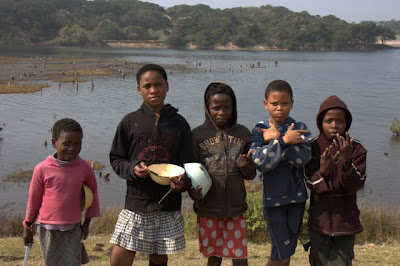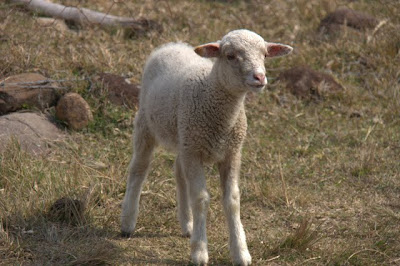Bulungula, Part Two
So when we last left off, I was in dire need of the bathroom. TMI, I know, but it is relevant to this story because as I mentioned in the beginning, Bulungula is an eco-lodge. This doesn’t just mean that you reuse your towel or sheets in the name of greenness; Bulungula is actually is carbon-neutral. This article from the Guardian describes their efforts best:
The lodge runs on solar and wind power and any CO2 emissions generated through gas and electricity usage are offset by the planting of slow-growing forest trees. Even the bread is baked in a solar oven – a huge mirrored dish that is tipped when needed to face the sun. Paper and cardboard are burned on-site (rather than driven all the way to the nearest recycling point) and all other rubbish is taken to the nearest town, Mthata. Clean water is collected from a spring or a rain tank, and all dirty water is soaked up by the surrounding banana and papaya trees, to produce fruit that is turned into smoothies using a bicycle-powered blender. The compost toilets are non-flushable, and the “rocket showers” are fuelled by paraffin. You simply pour it into the bottom of the drainpipe, throw in a handful of toilet paper, light it and voilà, you have a three-minute hot shower.
More aspects of Bulungula that make my idealist inner treehugger happy.
My practical self, however, was wondering what all of this eco-stuff was like in practice. I was pleasantly surprised. Turns out the compost toilets weren’t so bad. My criteria for judging a bathroom include a clean place to squat, toilet paper, and soap to wash your hands, and the Bulungula bathrooms have all of those things. The toilets look like regular toilets, but have two compartments: one for number one and one for number two. The two scoops of sand you dump in after using making use of the second compartment are supposed to cover up the smell, which worked, albeit not completely. The hardest part is compartmentalizing your bathroom usage, but it all worked out.
The rocket showers referred to above are quite interesting. I had some confusion over the right amount of paraffin to pour into the pipe, so I was a little concerned when the small fire turned into a large roar. I was certain throughout my entire shower that the pipe was going to combust, particularly when fire periodically shot out the opening. Of course, you are naked while you were pondering whether there is going to be an explosion, which means you are reluctant to check with anyone to see whether there is, indeed, a problem. Other than fear for your personal safety, the rocket shower does as promised and produces at least a trickle of hot water for your cleansing needs.
Maybe I should have focused my efforts on showering before I blew up the place instead of taking pictures
The rondavels where we stayed were simple and actually pretty nice, considering the ocean was just over the hill, as long as I ignored the fact we were standing on a cow dung floor.
Of course, being in the middle of nowhere, everything is just immensely more peaceful, and we spent time just soaking in the scenery and quiet.
The center of the lodge is the common building. At any given time, whether day or night, people from the village are hanging around the lodge, and some of them, including little kids, eat some of their meals there. Both nights we had delicious African meals for under $10 prepared by some of the villagers in the common lodge. The people at the lodge anticipate almost all of your needs, and one of those needs, of course, is beer. The lodge has beer and other beverages available for purchase (although not bottled water, so if you don’t want to drink the rain water they’ve collected, bring your own). The first night, we felt somewhat shy, as we mostly were the only non-Xhosa speakers around. After dinner, we were encouraged to join the drum circle that some of the locals started. After learning that I have no rhythm, as I expected, we opted out and went back into the common lodge, where we struck up a conversation with the guy from East London who picked us up on our way in. The vibe on the second night was totally different than the first, because we were joined by about 10 English-speaking American and European travelers. Both nights turned out to be quite fun.
Not everything at Bulungula is all puppies and rainbows, however. Our bed was filled with the overwhelming scent of mildew. I finally isolated the smell to the pillow. Removing the source made for uncomfortable sleeping, but at least the smell was gone. And as I would soon learn, seeing how the people lived in the village put any complaints like this in perspective.
It also was frustrating to get a clear answer, sometimes. This seems to be part and parcel of the experience, as this blog writer wrote back in 2007.
Now, having waxed about the place, Bulungula is not flawless in the way a time-challenged globe-trotting citizen of the world might like. Not everything happens on time (ok-most things don’t happen on time), not everything works all the time, and there are few English speaking people around to help you out with whatever you might need help with. So you may not get everything you want, and what you do get may not happen on time or in precisely the way you wanted or expected it, but you will get an African experience.
By “African” I don’t mean that things work on “African time” (wink, wink with a condescending smile…) or that all the people who work there are black and local or that the food is traditional local fare. (None of those things are always the case, by the way.) What I mean is that you’ll get an authentic collision of worlds at Bulungula, with all the frustrating, spontaneous, eclectic, maddening, serendipitous and perplexing implications, and very little assistance in dealing with it – for better or worse. People with deeply traditional rural African cultural upbringing (Xhosa, to be specific) and little formal education are in their environment and you (likely to be Western and/or urban, well educated and affluent by global standards) are coming to see them on their terms. Bulungula is a gateway, a transitional space, a facilitator. But don’t expect much help in telling you what you ought to do, how you ought to approach any particular situation, or how you should think about whatever you might encounter.
We saw this mostly on our village tour (more to come about that later), and also with the contradictory guidance to get into the place. We also couldn’t get a straight answer about where exactly we left our car. We wanted to retrieve our car so we wouldn’t have to take the shuttle out of there the next day, so we attempted to take the “short-cut” to general store where we left our car. Again, the directions were along the lines of go down there, turn left, follow the 4×4 tracks, turn right, etc. and once again, we got promptly got lost. Although there were brief moments of frustration (mostly by me) as we chugged along in the hot sun without water having absolutely no idea where the general store was, the walk turned out to be an adventure itself. As are most things on our trip, the more something puts us out of our element, the more interesting and rewarding it turns out to be.

Children walking back to the village after eating breakfast at Bulungula. I also took their individual pictures because they were all quite eager to show off their signs.

A lamb we encountered along the way. Lambs and sheep are kept by the villagers to eat on special occasions.












Hey Amy and Sean!!!! I think I figured out how to post a comment! I LOVE LOVE LOVE the pictures….So cool! Amy, I bet you were thrilled that those kids don’t wear pants! HeHeHe
Hope you are doing fantastic….miss you both!
Katie
That toillete looks way better then I pictured it! LOL
Hey guys! 🙂
Tim was just writing up a post about our time at Bulungulu, and it made me want to re-read your previous posts about it too. And after looking at your pictures I realized something: we stayed in the same rondavel as you guys! Too funny. 🙂